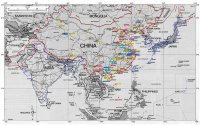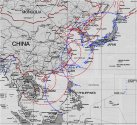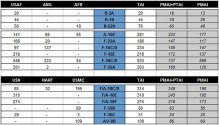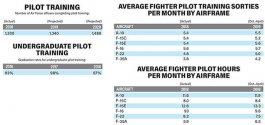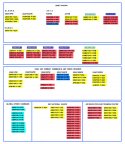Latest estimate of fighter regiments and orbat of the PLAAF number around 2200 jet fighter with 50% modern fighter like J10, J11, Su27, Su 30MKK etc via Icloo
translated Only 400 J7 left. they are making progress on fleet modernization It was not too long ago that PLAAF look like antiquated Air Force
By now it should be equal or larger than combine first tier fighter of Taiwan+ Japan +Korea say 350+350+450
But US Pacom is the elephant in the room
Total fighter Jets The total number of fighters: 2134
Modern fighter Jets The total number of advanced fighter: 1173 (SU-30MKK+SU-30MK2+SU-35SK+J-11B/BS+J-11BH/BSH+J-15+J-16+J-20+J-10 Series
Fighter Jets estimation done by eagle CJDBY on 2019-8-13, cut off date at 2019 July. Poster put on caveat : No Guarantee on accuracy as data came from unofficial sources.
Celebrate the August 1st Army Day, today is a rabbit Statistics on fighter power, statistics include the Rabbit Air Force and Naval Air Force. All data comes from roadside agencies and does not guarantee authenticity and accuracy. The time is up to July 2019.
SU Series : 161
Sukhoi Series: 161
SU-27SK/UBK: 40 (Air Force Sniper Aviation 4th, 16, 41, 55 Brigade)
SU-30MKK: 73 (Air Force Cangzhou Base Flight Training 3, Air Force Sniper Aviation 6th, 54th, 85th, and 99th brigade)
SU-30MK2: 24 (
Qinghai Air Strike Air Force 4th Brigade) SU-35SK: 24 (Air Force Sniper Air Force 6th Brigade)
J11/15/16 series: 597
J-11 /15/16 Series: 597
J-11A: 105 (Air Force Test Flight, Air Force Sniper Aviation 4th, 16, 41, 55 Brigade)
J-11B/BS: 220 (Air Force Cangzhou Base Flight Training 2, Air Force Dingxin Base Weapons Test Mission, Air Force Dingxin Base Blue Army Brigade, Air Force Sniper Aviation 1st, 19th, 89th, 95th, 111th Brigade)
J-11BH/BSH: 72 (Navy Aviation University, Haihang Sniper Aviation 8th Brigade)
J15 : 40
J-15: 40 (a group of Hainan Xingcheng carrier aircraft base)
J16: 160
J-16: 160 (Air Force Cangzhou Base Flight Training 3rd Regiment, Air Force Dingxin Base Evaluation and Test Center, Air Force Dingxin Base Blue Army Brigade, Air Force Sniper Aviation 3rd, 7th, 40th, 83rd, 98th Brigade)
J20: 30
J-20 series: 30
J-20: 30 (Air Force Zhangzhou Base Flight Training 3rd Group, Air Force Dingxin Base Evaluation and Test Center, Air Force Sniper Aviation 9th Brigade)
J10 series : 530
J-10 Series: 530
J-10A : 192 (Air Force Cangzhou Base Flight Training 1st Regiment, Air Force Ding New Base Blue Army Brigade, Air Force Sniper Aviation Brigade 8, 26, 34, 43, 70, 124, 130 Brigade)
J-10AH: 16 (Haihang Sniper Aviation 4th Brigade )
J-10AY: 8 carrier (Air Force flight demonstration team Bayi)
J-10B: 58 stand (Cangzhou Air Force base to fly a training mission, the Air Force fighter aviation brigade first 5,56,61)
J. 10C-: 120 carrier (Air Force Cangzhou Base Flight Training 1st Regiment, Air Force Dingxin Base Evaluation and Test Center, Air Force Dingxin Base Blue Army Brigade, Air Force Sniper Aviation 2nd, 5th, 72nd, and 131st Brigade)
J-10S: 124 (Air Force Cangzhou Base Flight Training 1st Regiment, Air Force Dingxin Base) Evaluation Test Center, Air Force Dingxin Base Blue Army Brigade, Air Force Sniper Air Force 2nd, 5th, 8th, 26th, 34th, 43rd, 56th, 61st, 70th, 72nd, 124th, 130th, and 131th Brigade)
J-10SH: 8 (Haihang sniper Air
Force 4th Brigade) J-10SY: 4 (Air Force Bayi Air Show Team)
J8 series : 132
J-8 Series: 132
J-8F/DF/HF: 96 (Air Force Sniper Aviation 78th, 109th Brigade, Sea Air Sniper Air Force 5th Brigade)
J-8FR: 36 (Air Force Reconnaissance Aviation Forces 46th, 93rd Regiment)
J7 series: 396
J-7 Series: 396
J-7G: 72 (Air Force Sniper Aviation, 34th, 44th, 52nd Brigade)
J-7L: 72 (Air Force Sniper Aviation, 21st, 53nd Brigade)
J-7E: 144 (Air Force Sniper Aviation, 25th, 88th, 97th, and 132nd Brigade)
J-7H: 108 (Air Force Sniper Aviation, 18th, 63rd , 125 Brigade)
JH7 series : 288
Flying Leopard Series: 288
JH-7: 32 (PLAN Aviation 6th regiment)
JH-7: 32 (Haihang sniper bombing aviation 6th brigade)
JH-7A : 256 (PLAAF Dinxing Weapon Testing Brigade, PLAAF Dinxing OPFOR Blue Force, PLAAF brigades 15, 31, 83, 110, 126th, PLAN Aviation University, PLAN 2nd training brigade, PLAN Aviation 5th regiment, PLAN Aviation 9th regiment)
JH-7A: 256 (Air Force Dingxin base weapons The test regiment, the Air Force Dingxin Base Blue Army Brigade, the Air Force Sniper Bombing Aviation, the 15th, 31st, 83rd, 110th, and 126th Brigade, the Naval Air University, the HNA Training Base 2nd Brigade, the Haihang Sniper Aviation 5th Brigade, and the Hainan Air Strike Bombing Air Force 9th Brigade)
total fighter Jets The total number of fighters: 2134
Modern fighter Jets The total number of advanced fighter: 1173Rack (SU-30MKK+SU-30MK2+SU-35SK+J-11B/BS+J-11BH/BSH+J-15+J-16+J-20+J-10 Series
its been 2 years, since these numbers were posted. Any update on what the current number is in terms of the numbers of Modern 4th Gen+ fighters?
I think this number will be the ultimate determinator of China's power. China's advances in the Navy or Ground Force matters much less compared to Air power which will determine if China can fight the US in the first Island Chain, within the range of its fighters and win. If China for example far surpasses US in modern fighter quality and quantity, then it will essentially force US out of East Asia since China's Air power will nullify whatever bases, ships and submarines US can bring. Air Power pretty much rules them all. Even Submarines cannot hide from Sub-hunting planes.
If China has enough modern fighters then it will achieve air superiority and dominate this entire region. Even Japan will not be safe from Chinese long range fighters like J-11 or J-20. China can essentially become the Israel of East Asia who can fly wherever they want and even in the air space of other countries and no one dares to shoot them down. Like Israel China can impose its will on everyone within the range of its fighters when they reach sufficient numbers.
If we look China's map and the range of J-11 and J-20, China can dominate South East Asian Countries like Myanmar, Vietnam and Thailand from its borders and even dominate Indonesia and Philippines from its South China Islands. Sufficient Air Power will even nullify India and it is even possible to project power all the way to Middle-East from Kashgar if H-20 comes online.
China's geographic position in the heartland of Asia allows it to project power all around asia with just Air Force planes alone. No need for Even Carrier based air power.
I think Once China's total number of Modern planes surpasses US, that will be end of US dominance of East Asia and South East Asia. So, I focus on this number the most.
Last edited:

